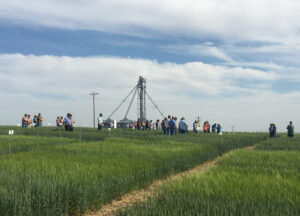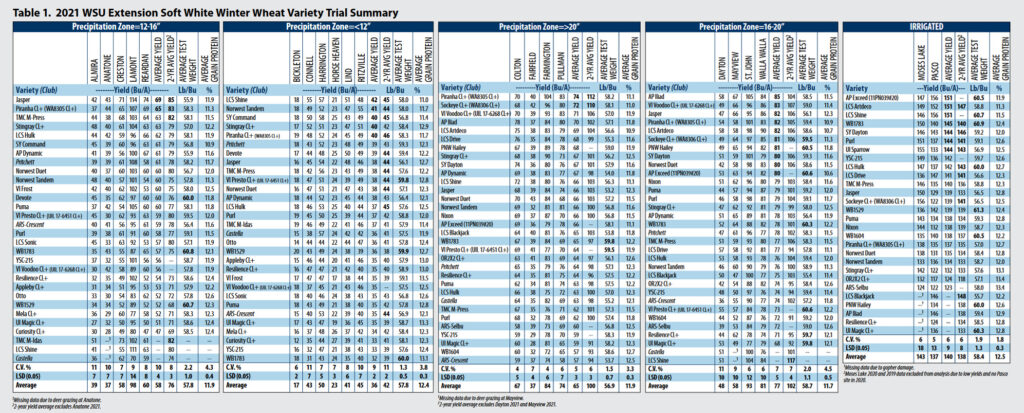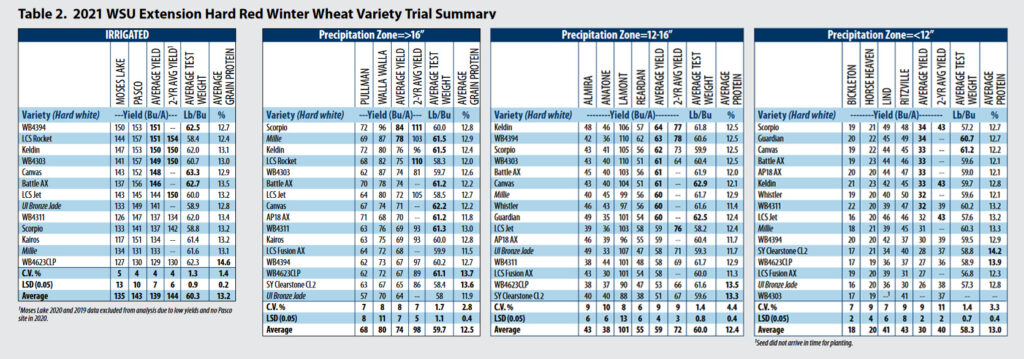By Clark Neely
No doubt about it, 2021 was a tough year, and many growers in Eastern Washington are facing the possibility of another rough year in 2022 with low soil moisture reserves in many areas and below-average winter and spring precipitation.
Yields and test weights were down nearly everywhere in 2021, and grain protein was up as much as two to three percentage points in spots. Luckily, public and private breeding programs continue to produce resilient varieties that are able to mitigate some of the negative impacts from the difficult growing environments we have recently experienced. Here is a synopsis of winter wheat variety performances for the different precipitation zones and wheat classes based on the Washington State University Extension Cereal Variety Testing Program results.
There were very few brand new named entries in 2021. On the soft white winter (SWW) side, AgriPro’s AP Exceed was first tested in 2021 in the high precipitation and irrigated zones. It landed near the trial average in the more-than-20-inch precipitation zone, but was in the top group in the 16-to-20-inch zone. VI Presto CL+ was tested for the first time by the Varsity Idaho program in the high precipitation zones, but was previously tested in the low precipitation zones. It was within one to two bushels of the trial yield average for all but the 16-to-20-inch zone, where it was four bushels under. Similarly, VI Voodoo CL+ was first tested in the low precipitation zones in 2021 where it landed within one to two bushels of the trial average.
Unlike the SWW trials, there were a number of new hard red winter (HRW) entries in 2021: Battle AX (Montech); Canvas, Whistler and Guardian (Colorado State University entries); AP18AX (AgriPro); and LCS Fusion AX (Limagrain Cereal Seeds). AP18AX and LCS Fusion AX are not being tested again in 2022. All but LCS Fusion AX and AP18AX landed in the top of the trial in both low precipitation zones.
SWW High Precipitation Zones
Piranha CL+ and Sockeye CL+ continue to perform exceptionally well in the high precipitation zones. In fact, they were the only two entries that were in the top group statistically for both the 16-to-20-inch and more-than-20-inch regions in 2021. Both are very similar for test weight and grain protein, landing near the top of the trials for test weight and some of the lowest in grain protein. VI Voodoo CL+ and AP Iliad also did very well in both precipitation zones for both 2021 and the two-year yield averages. Both were at or slightly above the trial for test weight and at or slightly below the trial average for grain protein. Some of the older varieties continued to do well also, despite the hot, dry conditions last year. LCS Artdeco, PNW Hailey and SY Dayton all tied VI Voodoo CL+ and AP Iliad for yield in 2021. LCS Drive did uncharacteristically well in 2021, likely due to its early maturity under the drought and extreme heat conditions.
In contrast, TMC M-Press and LCS Blackjack are varieties that have historically done well in these regions, but struggled to compete in 2021 compared to their long-term averages. Similarly, LCS Shine was closer to average in the more-than-20-inch zone in 2021, but was near the top in 2020. It did exceptionally well in both years in the 16-to-20-inch zone, however, no 2021 average is presented due to missing data at Mayview from deer grazing. On the two-year average, it stands alone as the best yielding variety for that zone.
Cameo is a new U.S. Department of Agriculture Agricultural Research Service winter club, recently named, with a high precipitation-targeted production region. It has a two-to-four-bushel yield advantage over other clubs and better stripe rust resistance and earlier maturity than ARS-Crescent.
SWW Low Precipitation Zones
Piranha CL+ landed in the top of the trial again in the below-16-inch precipitation zones. Likewise, TMC M-Press, Stingray CL+ and SY Command again did very well in both zones. LCS Hulk and TMC M-Idas were above average in the 12-to-16-inch zone, but were near average in the below-12-inch zone, whereas the opposite was true for LCS Shine and Norwest Tandem. Both AP Dynamic and Norwest Duet continued to land two to three bushels above the trial average, as they normally do.
Pritchett was the most consistent, high-yielding club wheat in each zone in 2021, though ARS-Crescent was as good or better than Pritchett on the two-year average. Pritchett, however, maintained much better test weight compared to ARS-Crescent. In 2021, Castella generally did not compete with Pritchett for yield in the low precipitation zones, though Castella was more competitive in the higher rainfall zones. Interestingly, Castella historically has had better test weight than Pritchett and ARS-Crescent on the long-term averages; however, that was not the case in 2021.
SWW Irrigated Zones
Several entries have missing data from Moses Lake in 2021 due to gopher damage. Of those not affected, AP Exceed, LCS Artdeco, LCS Shine, WB1783, SY Dayton, Purl and UI Sparrow all topped the trial for yield in 2021. Most of these grouped at the top on the two-year average as well along with LCS Hulk, LCS Drive, Sockeye CL+ and LCS Blackjack. Grain protein was elevated in 2021, but LCS Artdeco and LCS Shine were among the two lowest.
HRW High Precipitation Zones
Scorpio had an exceptional year all around and especially so in the high precipitation zone where it stood out statistically as the best yielding HRW variety. The next best yielding variety, Keldin, was eight bushels lower, followed closely by LCS Rocket, WB4303 and Battle AX. While LCS Rocket was closer to the trial average for yield in 2021, it statistically ties Scorpio on the two-year average. Canvas had the best test weight in the trial, while WB4623CLP and SY Clearstone CL2 had the best grain protein.
HRW Low Precipitation Zones
There was little separation among the top half of the trial in the 12-to-16-inch and below-16-inch zones in 2021, partly due to lower yields. Keldin, Scorpio, Battle AX, Canvas, Whistler and Guardian were all statistically in the top of the trial in both zones. WB4394 and WB4303 both did well in the -to-16-inch zone, but not as well in the below-12-inch zone; whereas the opposite was true for WB4311. On the two-year average, WB4394, Keldin and LCS Jet were the best in the 12-to-16-inch zone, and Scorpio, Keldin and LCS Jet were all tied for best in the below-12-inch zone. Canvas and Guardian stood out for maintaining phenomenal test weights despite the tough growing conditions, whereas WB4623CLP and SY Clearstone CL2 both had the highest grain protein in the trials.
HRW Irrigated zones
Data from Moses Lake and Pasco irrigated sites in 2021 concluded that WB4394, LCS Rocket, Keldin, WB4303, Canvas and Battle AX were all statistically tied for the best yielding in 2021. Out of these varieties, only LCS Rocket, Keldin and WB4303 have been tested for two or more years, and they also tie for best on the two-year average, along with LCS Jet. Canvas, Battle AX and WB4394 all had excellent test weight while WB4623CLP continued to have the highest protein.
New Ratings
In winter 2020-21 and fall 2021, weather conditions were conducive for generating new data for snow mold and emergence ratings. Based on this new data, Mela CL+ was rated the number one variety for snow mold, followed closely by Devote, Otto and Curiosity CL+, which all tied for number two. For emergence, Devote and Otto came in first, followed by Mela CL+ and Curiosity CL+ for second.
On the hard red winter side, Battle AX, Keldin, LCS Jet, WB4303, WB4394 and Sequoia were all rated the best on emergence; however, these were still only rated intermediate and were not rated as high as Devote, Otto, Mela CL+ or Curiosity CL+. WB4303 stood out as the best HRW variety for snow mold resistance, tying the number one SWW variety, Mela CL+.
 To view additional ratings and full trial results, visit smallgrains.wsu.edu/variety/variety-2021-data/. When possible, always use multiple years and locations within a region to better gauge the adaptation and yield stability of a particular variety. Growers and seed dealers are also encouraged to check out the new Washington State University (WSU) Variety Selection Tool mobile app for easy access to data on the go. WSU will be hosting a full, in-person field day schedule this summer, including the Lind Station Field Day in Lind and the Spillman Farm Field Day in Pullman (see next page). All WSU field days are listed online.
To view additional ratings and full trial results, visit smallgrains.wsu.edu/variety/variety-2021-data/. When possible, always use multiple years and locations within a region to better gauge the adaptation and yield stability of a particular variety. Growers and seed dealers are also encouraged to check out the new Washington State University (WSU) Variety Selection Tool mobile app for easy access to data on the go. WSU will be hosting a full, in-person field day schedule this summer, including the Lind Station Field Day in Lind and the Spillman Farm Field Day in Pullman (see next page). All WSU field days are listed online.
Acknowledgements: Funding for the WSU Extension Uniform Cereal Variety Testing Program is provided by the Washington Grain Commission. Variety trials are made possible by the contribution of land and time from farmer cooperators where the trials are located.
This article originally appeared in the May 2022 issue of Wheat Life Magazine.

Clark Neely, Ph.D.
Clark Neely is the cereal variety testing lead and extension agronomist at Washington State University. His research interests include dryland cropping systems and advancing cereal variety testing. Read more about Dr. Neely.


